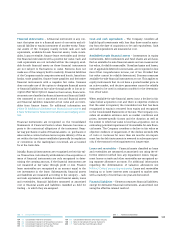Siemens 2011 Annual Report Download - page 268
Download and view the complete annual report
Please find page 268 of the 2011 Siemens annual report below. You can navigate through the pages in the report by either clicking on the pages listed below, or by using the keyword search tool below to find specific information within the annual report.
6 A. To our shareholders 51 C. Combined management’s discussion and analysis 23 B. Corporate Governance
in the disposal group are not part of the measurement scope
as defined in IFRS , Non-current Assets held for Sale and Dis-
continued Operations.
Income taxes – The Company applies IAS Income taxes.
Current taxes are calculated based on the profit (loss) of the
fiscal year and in accordance with local tax rules of the tax
jurisdiction respectively. Expected and executed additional
tax payments respectively tax refunds for prior years are also
taken into account. Under the liability method, deferred tax
assets and liabilities are recognized for future tax conse-
quences attributable to differences between the financial
statement carrying amounts of existing assets and liabilities
and their respective tax bases. The effect on deferred tax as-
sets and liabilities of a change in tax rates is recognized in the
income statement, unless related to items directly recognized
in equity, in the period the new laws are enacted or substan-
tively enacted. Deferred tax assets are recognized to the ex-
tent that it is probable that future taxable income will be
available against which the deductible temporary differences,
unused tax losses and unused tax credits can be utilized.
Inventories – Inventories are valued at the lower of acquisi-
tion or production costs and net realizable value, costs being
generally determined on the basis of an average or first-in,
first-out method. Production costs comprise direct material
and labor and applicable manufacturing overheads, including
depreciation charges. Net realizable value is the estimated
selling price in the ordinary course of business, less the esti-
mated costs of completion and selling expenses.
Defined benefit plans – Siemens measures the entitlements
of the defined benefit plans by applying the projected unit
credit method. The approach reflects an actuarially calculated
net present value of the future benefit entitlement for ser-
vices already rendered. In determining the net present value
of the future benefit entitlement for service already rendered
(Defined Benefit Obligation (DBO)), Siemens considers future
compensation and benefit increases, because the employee’s
final benefit entitlement at regular retirement age depends on
future compensation or benefit increases. For post-employ-
ment healthcare benefits, Siemens considers health care
trends in the actuarial valuations.
For unfunded plans, Siemens recognizes a pension liability
equal to the DBO adjusted by unrecognized past service cost.
For funded plans, Siemens offsets the fair value of the plan
assets with the benefit obligations. Siemens recognizes the
net amount, after adjustments for effects relating to unrecog-
nized past service cost and any asset ceiling, in line item Pen-
sion plans and similar commitments or in line item Other cur-
rent assets.
Actuarial gains and losses, resulting for example from an ad-
justment of the discount rate or from a difference between ac-
tual and expected return on plan assets, are recognized by
Siemens in the Consolidated Statements of Comprehensive
Income in the year in which they occur. Those effects are re-
corded in full directly in equity, net of tax.
Provisions – A provision is recognized in the Statement of Fi-
nancial Position when the Company has a present legal or
constructive obligation as a result of a past event, it is proba-
ble that an outflow of economic benefits will be required to
settle the obligation and a reliable estimate can be made of
the amount of the obligation. If the effect is material, provi-
sions are recognized at present value by discounting the ex-
pected future cash flows at a pretax rate that reflects current
market assessments of the time value of money. When a con-
tract becomes onerous, the present obligation under the con-
tract is recognized as a provision and measured at the lower
of the expected cost of fulfilling the contract and the expect-
ed cost of terminating the contract as far as they exceed the
expected economic benefits of the contract. Additions to pro-
visions and reversals are generally recognized in the Consoli-
dated Statements of Income. The present value of legal obli-
gations associated with the retirement of property, plant and
equipment (asset retirement obligations) that result from the
acquisition, construction, development or normal use of an
asset is added to the carrying amount of the related asset. The
additional carrying amount is depreciated over the useful life
of the related asset. Additions to and reductions from the
present value of asset retirement obligations that result from
changes in estimates are generally recognized by adjusting
the carrying amount of the related asset and provision. If the
asset retirement obligation is settled for other than the carry-
ing amount of the liability, the Company recognizes a gain or
loss on settlement.
Termination benefits – Termination benefits are recognized
in the period incurred and when the amount is reasonably es-
timable. Termination benefits in accordance with IAS , Em-
ployee Benefits, are recognized as a liability and an expense
when the entity has demonstrably committed itself, through
a formal termination plan or otherwise created a valid expec-
tation, to either provide termination benefits as a result of an
offer made in order to encourage voluntary redundancy or ter-
minate employment before the normal retirement date.
























